I brought up this question in my previous question on Connecting a Camera Hot Shoe to a homemade strobe, but there was no answer to this specific point.
Is there such thing as a "dark on" opto-isolator, that allows current to flow through pins 5 and 4 when no current flows trough pins 1 and 2, and blocks current through pins 5 and 4 when a current flows trough pins 1 and 2?
This will be like a normal opto-isolator, but it "turns on" when the LED is turned off, instead of the opposite.
